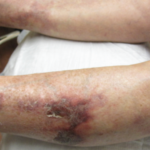Recommended action: Obtaining a platelet factor 4-heparin enzyme–linked immunoabsorbent assay (ELISA) and serotonin platelet release and discontinuing anticoagulation and inserting a retrievable inferior vena cava filter are recommended.
Subsequent diagnosis: Patient likely has heparin-induced thrombocytopenia with thrombosis, and PF4-heparin ELISA and serotonin platelet release assays are appropriate to make that diagnosis. Thrombolysis would be helpful for large pulmonary emboli and decompensated cardiac function but is not advisable because of the presence of low platelets. Similarly, use of argatroban and oral anti-II specific anticoagulations, which carry a high risk of bleeding complications, are not advised. These measures could be considered if, after discontinuation of LMWH, the patient’s platelet counts normalized over 80,000/µL. Lastly, bone marrow will not be specific enough to differentiate between peripheral platelet destruction due to heparin-induced thrombocytopenia versus idiopathic thrombocytopenic purpura (ITP). However, the scenario is less consistent with ITP.


